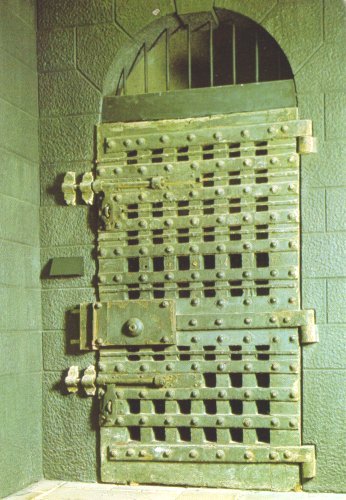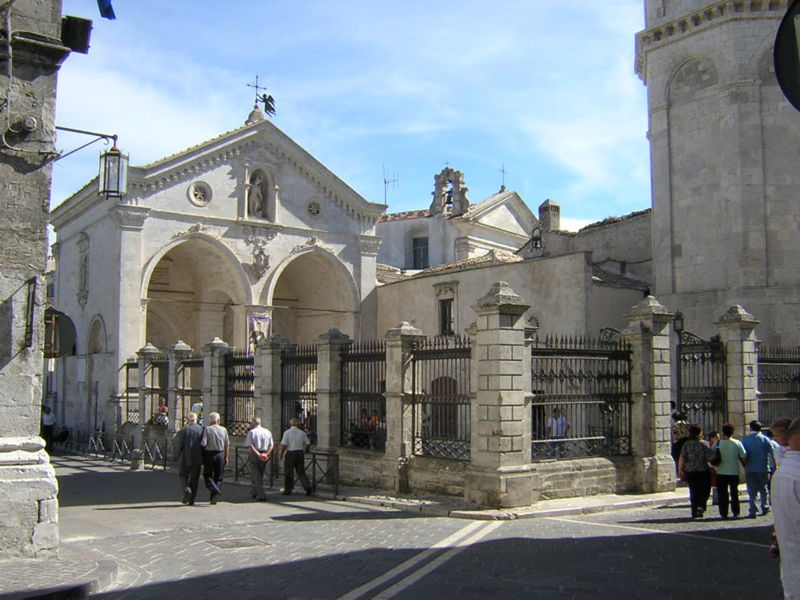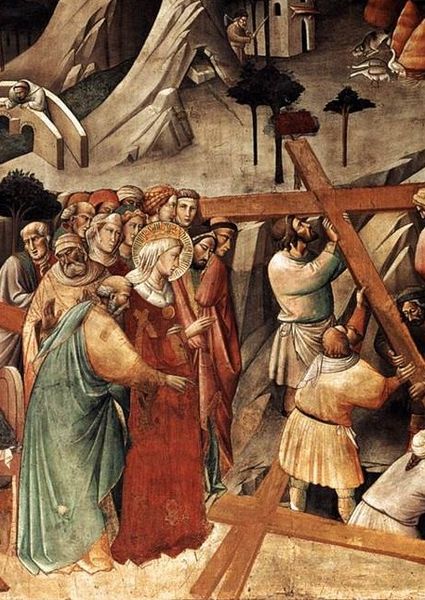St. Bernard of Clairvaux (1090-1153AD
Third Order of St. Francis - St. Joseph of Cupertino Fraternity - St. Peter of Alcantara Province. ``Where the Bishop is, there let the multitude of believers be; even as where Jesus is, there is the Catholic Church'' Ignatius of Antioch, 1st c. A.D
Pageviews last month
Saturday, May 31, 2014
THE ROMAN CATHOLIC CHURCHHer Doctrine and MoralsSunday after the Ascension1 June 2014 |
![[Image]](http://friarsminor.org/ss.gif)
The SundaySermon |
Dear Friend,
It is just as necessary that we feed our souls with the Word of God, as
we do with the Body of Christ. The Holy Ghost has been given to our
pastors so that they may feed our souls with the Word of God. They have
been given the admonition to preach in season and out of season. They
will be judged for their diligence or lack thereof in leading our souls
to the pastures of God's grace to feed our souls.
St. Caesarius of Arles, tells us that our priests are like cows that
feed upon the lush grass of the Sacred Scriptures, and having eaten,
they now produce milk to feed our souls. Cows eagerly seek out their
calves so that they may nourish them, and see them grow big and strong.
In this vein, St. Paul speaks of having given us milk, because this is
what we need, rather than meat, The calves, also, must be eager for the
milk of the cows. We often see calves that are so eager that they often
almost lift the cow off of the ground to obtain the nourishing milk that
she produces.
Our priests are, therefore, under obligation to feed themselves upon the
Word of God, and to take this and, in a manner, convert It to milk so
that we may easily digest it. They are to be burning with desire to give
us this milk so that we may grow strong in the faith. In a similar
manner, we must be eager for this spiritual milk. We must come with such
eagerness that we seem to knock the priest over. We must be ever eager
to be further nourished by this heavenly food.
Sadly, we find that there are few priests eager, (perhaps they are no
longer even able) to bring the Word of God to us in the pleasant and
tasteful manner of milk. Just as shocking, is the fact that there are
few if any who are eager to nourish their souls with this milk. If the
people would demand it like a hungry calf demands milk from its mother,
then the priest would soon begin to produce it; and the more it is
demanded the more he would produce. Of course, the priests do not
produce this of themselves, but it is the Holy Ghost that produces it
through them.
All too often, people come to hear the priest just as they come to
listen to a radio program, or a concert. They want to be entertained. As
soon as the Word of God is read, or is preached to them, they sit back
and relax, awaiting some amusement. With this attitude, it is no wonder
that they find It boring, and have little or no interest. Consequently
they find no spiritual nourishment in the Word of God.
These poor souls suffer from a disease of the soul, similar to a disease
of the body that destroys a person's appetite. They refuse to take
nourishment and gradually wither up and die. We might have to be forced
for a time to take nourishment, but once we have tasted how good and
sweet It is, we soon will seek it out more and more.
As little children, let us remind ourselves of how we are to receive
this Food for our souls. When we hear the Gospels read to us, the proper
bodily position is to be standing — ready to hear and to put into
action. Those who are truly unable to stand, may sit, but must be eager
to attune their ears so that they may not miss anything. All too often,
when the young and healthy see the exceptions made for others, they
begin to think that the exception is for all. They begin to assume a
less than perfect bodily posture, and soon their ears are no longer
attentive either; and their minds are off in another direction. They
leave not only, unnourished, but even develop distaste for this most
necessary food for their souls. Faith gradually dies out, and charity
grows cold, and they spiritually die from malnutrition.
We must likewise remember that it is not the priest that is speaking to
us, but rather God Himself. He speaks to us through the priest. The
priest may be the worst of speakers, but if we are eager to hear and
feed upon the spiritual food for our souls, the Holy Ghost will put the
words we need to hear in his mouth. If we are truly desirous for this
most necessary Food, God will give it to us. It may come to us in the
humblest and perhaps the most unworthy of instruments, but it is
nonetheless the same nourishing Heavenly food for our souls. Rather,
than blame the priest, let us look to ourselves; God gives us the guides
and rulers that we deserve. If our priests are not what they should be,
perhaps it is because we are not worthy enough to have better priests.
If we accept with grateful hearts the little we are given and are ever
eager for more, God will give us that which we desire.
Let us pray for our priests, that they may be made perfect instruments
of God's grace so that we may obtain the nourishment we need for our
souls. Perhaps, even more importantly, we must pray and act in a manner
that we may receive and benefit from the nourishment that God has given
us; and that He may continue to feed us and help us grow stronger in
Faith and Charity from day to day.
June 1 – Kidnapped for Christ
Bl. John Story
(Or Storey.) Pembroke College, Oxford
Pembroke College, OxfordMartyr; born 1504; died at Tyburn, 1 June, 1571. He was educated at Oxford, and was president of Broadgates Hall, now Pembroke College, from 1537 to 1539. He entered Parliament as member for Hindon, Wilts, in 1547, and was imprisoned for opposing the Bill of Uniformity, 24 Jan.-2 March, 1548-9. On his release he retired with his family to Louvain, but after the accession of Queen Mary he returned to England (Aug., 1553), and became chancellor to Bishop Bonner.
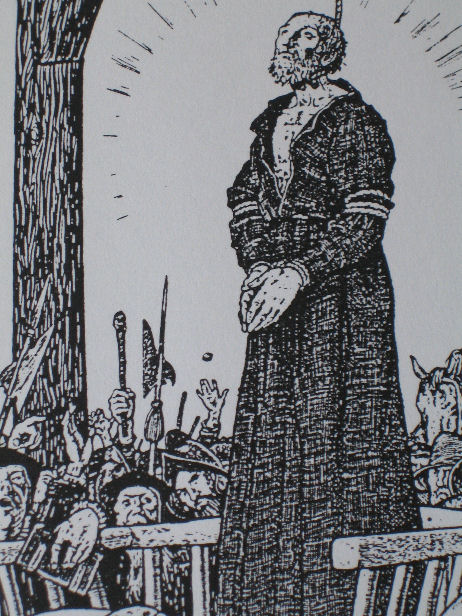
From 1553 to 1560 he sat for one or other parliamentary division of Wiltshire, and in the latter year he incurred the displeasure of Elizabeth for his outspoken opposition to the Bill of Supremacy. He was committed to the Fleet, 20 May, 1560, but escaped, was re-arrested and imprisoned in the Marshalsea (1563). He once more made good his escape to Antwerp, where he renounced his English allegiance and became a Spanish subject. Under the Duke of Alba he held a position in the customs of Flanders until August, 1570, when he was kidnapped at Bergen-op-Zoon by Cecil’s agents. He was brought to London and imprisoned in the Tower, where he was frequently racked, and on 26 May, 1571, he was indicted in Westminster Hall for having conspired against the queen’s life and for having while at Antwerp assisted the Northern rebels. The saintly martyr bore his tortures with fortitude, asserted over and over his innocence of the charges, but refused to make any further plea, on the ground that he was a Spanish subject, and that consequently his judges had no jurisdiction. The spectacle of this trial moved Edmund Campion, who was present in the Hall, to reconsider his own position and opened his eyes to his duty as a Catholic. Blessed John Story was condemned 27 May, and spent his last night in the Tower, preparing for a death which his persecutors made as barbarously cruel as it was possible.
Camm, Lives of the English Martyrs, II (London, 1904-5), 14; Pollard in Dict. Nat. Biog., s. v.
JOHN B. WAINESWRIGHT (Catholic Encyclopedia)
Friday, May 23, 2014
THE ROMAN CATHOLIC CHURCHHer Doctrine and MoralsDedication of the Patriarchal Basilica of Assisi25 May 2014 |
![[Image]](http://friarsminor.org/ss.gif)
The SundaySermon |
Dear Friend,
When St. Francis died, his body was solemnly taken to Assisi, and placed
in the church of St. George. Before he left this world, he requested
that his body be buried on the "Hill of Hell" a place where criminals
were executed. Gregory IX had a magnificent church built on the "Hill of
Hell" which he called the "Hill of Paradise." The construction was
completed after two years and with a great concourse of pilgrims, the
body was transferred with great pomp to the new church on May 25, 1230.
On May 25, 1253, Innocent IV solemnly consecrated the building. Benedict
XIV raised it to the rank of a Patriarchal Basilica.
The house of God is the most awesome place for men here on earth. Our
Holy Mother Church has gone to great lengths to adorn and embellish her
churches so that we might be impressed by the majesty of being in such
intimate proximity to God. The house of God brings us into the true
presence of God; because Jesus Christ is present in the Holy Eucharist.
As true God and true man He is hidden under the appearances of simple
bread and wine.
The design, embellishments, and decorations of the church are
deliberately made so that our hearts and minds will be lifted up to God.
The rising columns, the vaulted ceilings, the paintings, statues, all
colors and textures; are the best of man's ability to give honor and
glory to God. The best artisans and builders are obtained and inspired
to give their all to the project. Cost often was no object, as Catholics
are always eager to make sacrifices for the glory of God. The church is
truly Heaven on earth. In the church, we kneel, in the presence of the
magnificent and all powerful God. It is our portal into eternal glory.
In the church we obtain a taste of what heaven must be like.
Many would imagine that St. Francis would be at odds with all this
material wealth and beauty. It is true that St. Francis loved poverty
and simplicity, but it is also true that he would exhaust himself as
well as all his resources for the House of God. He would often sweep and
clean out the churches as well as repair them with his own hands.
The Modernists, who have taken over the churches, have removed the
divine presence from the buildings. They have removed the tabernacles,
they have invalidated the Eucharist, and they preach the Rights of Man
as opposed to the Rights of God. Often, the physical buildings maintain
some of their material beauty, and they are awesome testimonies of the
ingenuity and brilliance of man's abilities. However, without the true
presence of the Holy Eucharist, they are nothing more than museums or
monuments to men. Even the religious themes of the artwork lose their
meaning when they are separated from their intended proximity to the
Real Presence. What Jesus had condemned in the Temple has now taken
place in the churches. "My house is a house of prayer; but you have made
it a den of thieves." Many continue to attend the buildings even after
God was driven out. This was a deliberate design. The people mistook the
buildings for the Church and the true Faith, and now the churches are
churches of men rather than houses of God.
The true temple, however is not made by the hands of men. God's desire
was not to be hidden away in a building no matter how beautiful it may
be. The desire of God is to live in our hearts and souls. Our bodies are
the temples that God wishes to live in. When Jesus said that men would
destroy the Temple and He would rebuild it in three days, He was
speaking of His body not of a temple built by the hands of men.
Likewise, we must realize that our bodies are temples more beautiful and
precious than the greatest of cathedrals.
The committing of sin and driving God and grace out of our bodies and
souls is a much greater sacrilege than the desecration and driving Him
out of material buildings. The best adornments for the Temples of our
bodies are the virtues especially treasured by St. Francis: humility,
modesty, poverty, chastity, obedience, faith, hope, and most of all
charity. We often consider the modern churches and observe that they are
empty and naked, but sadly this is what is happening to so many
people's bodies. They are empty of any virtue, and often lacking in
sufficient or decent clothing. The numerous piercings and tattoos make
one think of graffiti desecrating the walls of our once sacred churches.
In fact, because our bodies are more sacred than material buildings,
the desecration is all the more evil. Our bodies are often not only
desecrated themselves but they are used to tempt and destroy the life of
grace in the bodies and souls of those around us.
We may not be able to do anything about the takeover of our churches by
the Modernists, but we still have control over the more sacred temples
of our bodies. Let us strive to make them beautiful and worthy places
for God to dwell, until we are eternally united with Him in Heaven.
Blessed John Forest
Born in 1471, presumably at Oxford, where his surname was then not
unknown; suffered 22 May, 1538. At the age of twenty he received the
habit of St. Francis at Greenwich, in the church of the Friars Minor of
the Regular Observance, called for brevity’s sake “Observants”. Nine
years later we find him at Oxford, studying theology. He is commonly
styled “Doctor” though, beyond the steps which he took to qualify as
bachelor of divinity, no positive proof of his further progress has been
found. Afterwards he became one of Queen Catherine’s chaplains, and was
appointed her confessor.
On 8 April, 1538, the holy friar was taken to Lambeth, where, before Cranmer, he was required to make an act of abjuration. This, however, he firmly refused to do; and it was then decided that the sentence of death should be carried out. On 22 May following he was taken to Smithfield to be burned. The statue of “Darvell Gatheren” which had been brought from the church of Llanderfel in Wales, was thrown on the pile of firewood; and thus, according to popular belief, was fulfilled an old prophecy, that this holy image would set a forest on fire. The holy man’s martyrdom lasted two hours, at the end of which the executioners threw him, together with the gibbet on which he hung, into the fire.
Father Forest, together with fifty-three other English martyrs, was declared Blessed by Pope Leo XIII, on 9 December, 1886, and his feast is kept by the Friars Minor on 22 May. Some years ago rumor was current that the relics of the martyr had been taken to Spain, and were preserved at a residence of the Friars Minor somewhere in the north of that country. In 1904 the writer of this article made inquiries, to which the Provincial of Cantabria replied that the fathers there were not aware of the existence of the holy relics in any part of Spain, and that they thought the rumour was unfounded. It seems therefore most probable that the mortal remains of Father Forest still lie hidden at Smithfield, near the corner of St. Bartholomew’s Hospital, opposite the gate of the ancient priory.
(Catholic Encylopedia)
Monday, May 12, 2014
May 13 – “Can anyone receive Jesus into his heart and not die?”
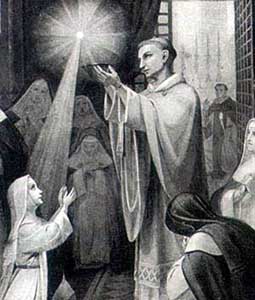
Imelda was born in 1322 in Bologna, the only child of Count Egano Lambertini and Castora Galuzzi. Her parents were devout Catholics and were known for their charity and generosity to the underprivileged of Bologna. As a very young girl, Imelda had a burning desire to receive Christ in the Most Holy Eucharist. On her fifth birthday, she requested this privilege.
However, Church custom at the time was that a person did not receive his or her First Holy Communion until age 12. Imelda was sorely disappointed but knew the time would come soon enough. She would sometimes exclaim: “Tell me, can anyone receive Jesus into his heart and not die?”
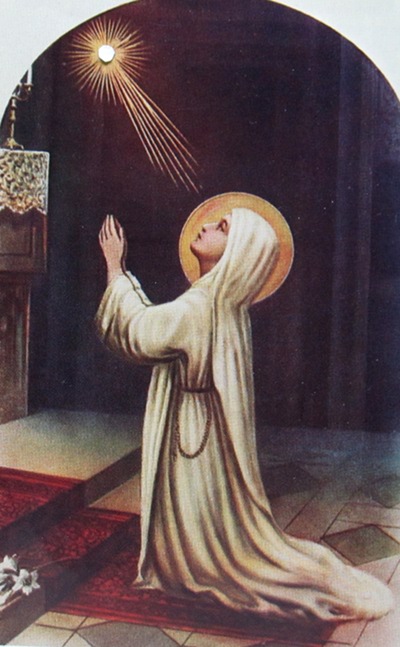
As time went by, her desire for the Blessed Sacrament grew, and she loved Christ more than ever. To show this love, she joined a cloistered Dominican community at age nine in Valdipietra, near Bologna . (It was unusual at the time for a girl her age to enter the convent). There it would be easier to wait for her First Communion, in deep prayer and conversation with God.
On May 13, the day of the vigil of the Ascension, in 1333, she finally got her wish. As she knelt in prayer the “Light of the Host” was witnessed above her head by the Sacristan, who then fetched the Priest so he could see. After seeing this miracle, the Priest felt he had to give Blessed Imelda her Holy Communion. Immediately after receiving the Holy Eucharist, Imelda fell to the floor and died in complete ecstasy. Her remains are in Bologna, Italy, at the Church of San Sigismondo, beneath the wax effigy of her likeness. There still remains some controversy as to whether Blessed Imelda can be classified as incorrupt. Many argue that contrary to popular belief, she is not truly incorrupt. Many other sources, including the Church of San Sigismondo, steadfastly claim that she is incorrupt.
She was beatified by Pope Leo XII in 1826.
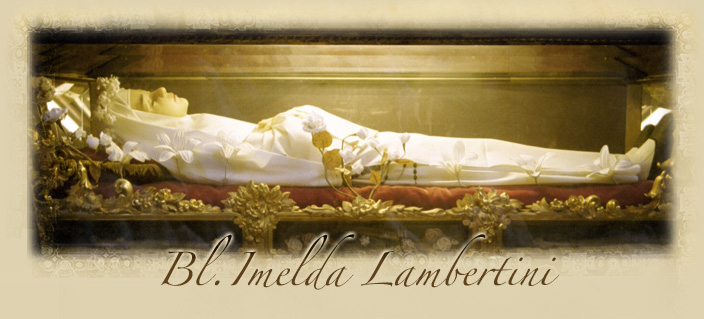
Friday, May 9, 2014
THE ROMAN CATHOLIC CHURCHHer Doctrine and MoralsFeast of Sts Philip and James, Apostles11 May 2014 |
![[Image]](http://friarsminor.org/ss.gif)
The SundaySermon |
Dear Friend,
Today, we find the Mass for the third Sunday after Easter has been set
aside in favor of the Mass for the feast of Saints Philip and James.
This simple fact should remind us of how important our Holy Mother the
Church considers today's feast. There are occasions when one feast will
outrank another and the outranked feast will be commemorated (like
today) and there are other occasions, when the outranked feast is
completely suppressed or transferred to another date. The Catholic
calendar is not a haphazard collection of anniversaries of people and
events; it is a serious and deliberate work for our instruction, growth,
and sanctification. We would do well to consult the calendar every day.
In this manner we can unite (at least in spirit) with the sentiments
and celebrations of the Church. We can fast and do penance with the
Church, and we can rejoice and celebrate with Her as well — each in its
own proper season and place. Today we celebrate the solemn translation
of the bodies of these saints to their current resting place in the
church of these Apostles in Rome.
St. Philip came from Bethsaida in Galilee. It was to St. Philip that
Jesus addressed Himself before He multiplied bread and fish for the
multitude. In today's gospel (John 14, 1-13) we see that Saint Philip
enjoyed a certain familiarity with Jesus as he asked: "Lord, show us the
Father, and it is enough for us." He frequently acted as an
intermediary for the Gentiles who wished to speak to Jesus. According to
ancient traditions, after Pentecost he preached in Phrygia and died on a
cross a Hierapolis.
St. James is surnamed the Less to distinguish him from James the brother
of John. He was a native of Cana in Galilee and was a cousin of Jesus.
He became the first bishop of Jerusalem. The High Priest called on him
to deny Jesus; on his refusal, he was thrown down from the terrace of
the Temple, and his head broken with a club. The names of Saints Philip
and James are mentioned in the Canon of the Mass.
"In My Father's house there are many mansions." Jesus has gone to
prepare a place for us. The desire of God from all of eternity is to
have heaven filled with the sons of men. He has called each and every
one of us. It is His will that we all join Him in Heaven. But, He will
not force us into Heaven nor will He force us to love Him. We are told
that there is a place in Heaven for us. It is ours, if only we enter in
there. Before Jesus came and sacrificed Himself Heaven was closed to us.
Now since Jesus' death on the Cross and His daily unbloody sacrifice of
the Mass Heaven is open to us. The only thing that prevents us from
entering in there is sin or our own perverted wills.
We all cannot be virgins like so many of the saints on our calendars;
nor can we all be martyrs; apostles; doctors; or confessors. We all can,
however, be penitents. We are all sinners and in need of penance.
However, no matter what we are here and now, there is a place for us in
Heaven. We are all called upon to be saints. There each of us will be
rewarded according to the degree of our charity. Those with the greater
love of God will obviously be nearer to Him than the others.
Sadly, there are also many levels in Hell. The devils have imitated
(mocked) God by preparing a place for us there too. In this place of
eternal suffering, there are degrees also relating to the distance one
has placed between himself and God.
There is, therefore, a war going on for our souls. God wants us and
seeks to draw us near Him with love; the devils want us and seek to draw
us near to them with hatred of God. The choice is our own. No doubt
that God has done and will continue to do all He can to help us to
choose Him and love rightly and thus end well; but the demons are
likewise doing all that they can to undermine the grace of God in us so
that we will turn away further and further from God.
Seeing this, like St. Philip did, we are inclined to say to Jesus also,
"Show us the Father." We want to see, and touch and thus know — rather
than believe. This however, is not really for our benefit. Jesus tells
us that we see the Father in Him, and Him in the Father. We see the
Divinity hidden in the humanity of Jesus. We see God hidden in the
Sacred Species of the Altar. With the eyes of faith we can see God; and
so it is with the eyes of faith that we advance in the degrees of
charity. When the faith is turned away from or denied, then we see less
and less clearly the Divinity; and charity grows colder and colder in us
until we are so far removed from true faith and charity that we give up
all hope and cast ourselves into Hell with the devils that have gone
before us.
If we cooperate with the grace of God, we will gradually see more and
more clearly the Father in the Son. We will see the Divinity in
humanity. We will see God in the Holy Eucharist. The understanding of
these things began with Faith, and will increase with Faith. This Faith
will give us Hope and Charity. Of course, it is Charity that instills in
us the first desire to see the Father. These three virtues work
continually; each increasing in us the others. The beginning comes from
God, and it is God who works in us the accomplishment of these virtues;
but it is our cooperation that allows Divine Providence to move forward
with the salvation of our souls.
Let us listen to the words of Our Lord as He speaks to us with the same
words He spoke to Saint Philip. "He that seeth Me seeth the Father."
When we adore the Holy Eucharist we adore Jesus; we adore God! Unless,
through Faith, Hope, and, Charity, we recognize this, we will never
enter the place in Heaven God has prepared for us.
Thursday, May 8, 2014
May 8 – When St. Michael Appeared
To his intercession the Lombards of Sipontum (Manfredonia) attributed their victory over the Greek Neapolitans, 8 May, 663.
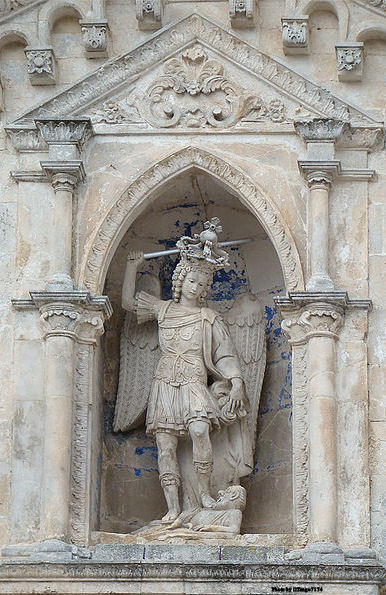
Statue
of St. Michael overlooking the main entrance at the Sanctuary of Saint
Michael the Archangel, Monte Sant’Angelo, Apulia, Italy.
(cfr. Catholic Encyclopedia)
Saturday, May 3, 2014
THE ROMAN CATHOLIC CHURCHHer Doctrine and MoralsSecond Sunday after Easter4 May 2014 |
![[Image]](http://friarsminor.org/ss.gif)
The SundaySermon |
Dear Friend,
Jesus Christ is the true Shepherd. He is also the Door. All those who
enter by any other way than the door are wolves or thieves. The bishops
and priests often are one or the other. They are true shepherds when
they care for the people as Christ did and are ever vigilant for their
spiritual welfare. They are wolves or thieves when they use their
position only to receive for themselves worldly advantages.
There is another position that Our Lord speaks of. That is the hireling.
Perhaps the majority of the bishops and priest have fallen into this
category. The saints inform us that the hirelings do well as long as
they are not under attack. The scriptures even admonish us to heed their
advice, but be careful not to imitate their actions. They speak truths
but their actions are false. "The scribes and the Pharisees have seated
themselves on the chair of Moses; whatsoever they say, do ye; but
according to their works, do ye not." (Mt. xxvii, 51; II Cor. Iii 16,
15; Mt xxiii 2, 3) When the hireling sees the flock under attack he
flees from his post. He is unconcerned about the welfare of the flock;
his only concern is his comfort and to save his own mortal flesh. He
cares little for his own soul and even less for the souls of the people.
In considering the world wide apostasy, we keep wondering: how could
this have happened? Today's gospel offers us an insight into what may
have happened.
First, the wolves and the thieves found their way in; not through the
door, but some other way. The Satanists and their lackeys, the
Freemasons, entered into the Church. Their entrance was not a natural
one and was therefore illegal and not valid. Having professed allegiance
to the devils and to the destruction of the Church and all that is of
God, they could not have the necessary intention of doing what they
Church does. No doubt they feigned having the true faith in order to
gain entrance into the highest positions. These elements of a fifth
column began the systematic dismantling of the Church from within. What
they could not accomplish from centuries of external attacks, became
relatively easy once they were within. In a short time, the doctrines
were watered down and eliminated. The Mass was attacked so that it would
be acceptable to the Protestants (and therefore no longer a true Mass
at all). Under the guise of holding a "pastoral council" (Vatican II),
the doctrines were undermined with all the traditions of the Church.
Secondly, it appears that the majority of the other bishops were nothing
more than hirelings. Some perhaps, knew so little of the faith that
they never suspected anything. The majority, it seems, saw very clearly
what was happening, and remained silent or went along with it, because
they were hirelings and did not want to lose their position or their
income. Many priests were heard to say that they were just keeping their
mouths shut, because they did not want to lose their retirement
benefits.
So, the wolves and thieves came in. They, devoured, destroyed, and
devastated the faith of the people. The hirelings sat back and said
nothing or even went along with it, because the usurpers and intruders
held the promise of their hire over their heads.
The true shepherds were ignored and pushed aside. Their cries of foul
fell upon mostly deaf ears as everyone seemed to be intoxicated with the
new spirit that had entered the Church. The worldly celebration was
intoxicating and drew the majority with it. The ignorant never realized
that the new spirit of the Church, was not the Holy Ghost. The devils
had usurped that position, and their wolves and thieves (who entered not
by the Door) were greatly singing up the praises of this demonic
spirit. It was in this way that the false church of "Vatican II" usurped
and took over all the material property of the true Church. Now they
present themselves as the successors of the Apostles, and have the
acceptance and approval of the world.
The true shepherds not only cried foul and tried to point out to the
world what had taken place, but set out to preserve the Church, by
consecrating true bishops. They stated simply and clearly that these men
who were Freemasons and Satanists, were not true Catholic priests,
bishops, or popes. The Apostolic See of St. Peter was vacated when these
men entered in. Likewise, the "bishops" who were Freemasons and
Satanists had rendered their once Catholic sees vacant. The "bishops"
who were hirelings and sold out to the wolves and thieves, were now no
longer working for God or the Church but were hired out to the devils;
hence, their sees were likewise vacated. Unity in any form with this new
church is not possible. There is no unity of the Holy Ghost with the
demonic spirits. There is no unity with truth and falsehood. Evil often
puts on the appearance of Good, but this by no means renders it true or
good, nor does it oblige us to accept it as having authority.
Bishop Ngo, courageously stood up, and declared that the See of Peter
was vacant. Those in union with the false pope had likewise vacated
their sees. Bishop Ngo, as a true shepherd, consecrated true successors
to the apostles so that the Church would continue. Today, we have only a
few legitimate successors to this faithful guardian of the flock of
Christ. Let us thank God for the continuation of His Church in these
men: Bishop Giles OFM, Bishop Bonaventure OFM, and Bishop Madrigal. Pray
that they may ever remain good shepherds, to teach, guide, and rule us
so that we may not be led away by the many and various Judas goats.
Friday, May 2, 2014
May 3 – Finding of the Holy Cross
 The Vision of Saint Helena by Paolo Veronese
The Vision of Saint Helena by Paolo VeroneseIn the year 326 the mother of Constantine, Helena, then about 80 years old, having journeyed to Jerusalem, undertook to rid the Holy Sepulchre of the mound of earth heaped upon and around it, and to destroy the pagan buildings that profaned its site. Some revelations which she had received gave her confidence that she would discover the Saviour’s Tomb and His Cross. The work was carried on diligently, with the co-operation of St. Macarius, bishop of the city. The Jews had hidden the Cross in a ditch or well, and covered it over with stones, so that the faithful might not come and venerate it. Only a chosen few among the Jews knew the exact spot where it had been hidden, and one of them, named Judas, touched by Divine inspiration, pointed it out to the excavators, for which act he was highly praised by St. Helena. Judas afterwards became a Christian saint, and is honoured under the name of Cyriacus.
After the happy discovery, St. Helena and Constantine erected a magnificent basilica over the Holy Sepulchre, and that is the reason why the church bore the name of St. Constantinus. The precise spot of the finding was covered by the atrium of the basilica, and there the Cross was set up in an oratory, as appears in the restoration executed by de Vogüé. When this noble basilica had been destroyed by the infidels, Arculfus, in the seventh century, enumerated four buildings upon the Holy Places around Golgotha, and one of them was the “Church of the Invention” or “of the Finding”. This church was attributed by him and by topographers of later times to Constantine. The Frankish monks of Mount Olivet, writing to Leo III, style it St. Constantinus. Perhaps the oratory built by Constantine suffered less at the hands of the Persians than the other buildings, and so could still retain the name and style of Martyrium Constantinianum. (See De Rossi, Bull. d’ arch. crist., 1865, 88.)
(cfr. Catholic Encyclopedia: Cross and Crucifix)
Subscribe to:
Posts (Atom)

